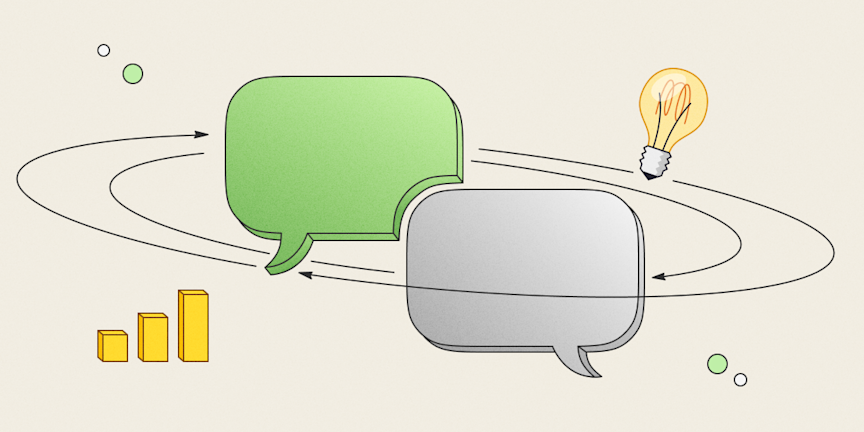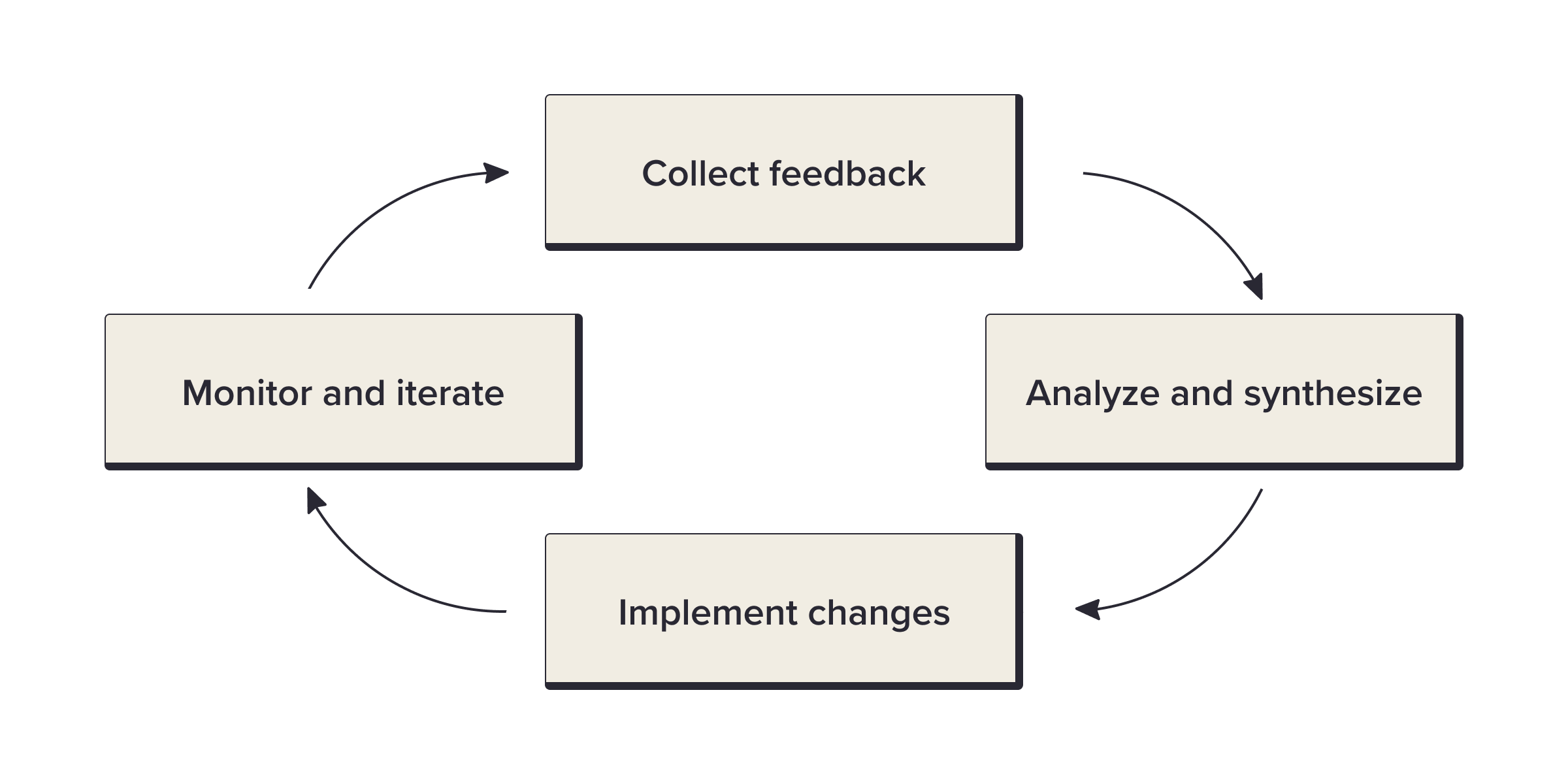How do feedback loops and retrospectives work together?


Staying on top of market shifts and ahead of competitors is most likely a key part of your business strategy. But do you have the systems in place to achieve these ambitions?
Building feedback loops is essential, because they give you the insights you need to more effectively address the pain points, expectations, and aspirations of your target audience.
And one of the greatest drivers of a feedback culture (that you might be overlooking) is retrospective meetings. These meetings spark important reflections, conversations, and initiatives that constitute the continuous improvement you’re striving towards.
Let’s take a look at how feedback loops drive innovation, and the important role that retros play in that cycle…
In this article, we will explore the following topics:
What is a Feedback Loop?
A feedback loop is the process of gathering, analyzing, and implementing feedback.
Once ideas and solutions are deduced from the feedback received and put in place, monitoring their impact is also really important. This is the natural transition into the next feedback loop, as you gather further feedback to analyze, synthesize, and implement once again.
When effective feedback loops are in place, one improvement leads to another…and another…and another after that.

How Feedback Drives Continuous Improvement (with 4 real-world examples)
When the cycle of feedback happens repeatedly, it leads to incremental improvements over time. Products, services, experiences, and processes become more effective, intuitive, efficient, and beneficial to the people interacting with them.
Why? Because rather than using assumptions or initial research to inform your entire strategy and approach, you’re running tests on smaller solutions and course-correcting as you go. This makes it far more possible to adapt to evolving user needs, industry trends, emerging technologies, and other winds of change.
Let’s take a look at some of the core business components that benefit from strong feedback practices. Each of these factors work together towards a strong, resilient, and thriving organization—and each of them can make or break your company’s success.
The Product Lifecycle and Innovation
Understanding what delights, frustrates, and confuses your customers about your products means you can emphasize the things that make those products great, and improve upon the things that cause friction.
Customer feedback informs your strategies around the products themselves, but it goes beyond that, too. Your teams can integrate customer feedback into any services or customer support your company offers, your marketing and advertising efforts, your production pipelines, and more.
Real-World Example: Nestlé
A major player in the food and beverage industry, Nestlé is committed to being a customer-centric brand. They rely on customer insights to fuel their product and innovation strategies, and use online surveys to gauge interest in new product concepts before they move into production. Beyond soliciting customer feedback, the brand also taps into what their customers are saying in user-generated content (UGC) like reviews and social media posts.
“Consumers do the talking for us. They speak, and we listen and take action.”
– Lee Beech, Director of Consumer Experience at Nestlé Canada for Bazaarvoice
Team Development and Performance
High performance isn’t something that just happens. Strong collaboration skills and healthy team dynamics are formed when people are empowered in their strengths and given the space to take risks and make mistakes.
The thing that really ties these factors together is feedback. When teams are able to exchange feedback in a way that’s constructive, they can improve together in not just their outputs, but also the processes they employ to get to those outputs.
Real-World Example: New Zealand All Blacks
The notoriously successful All Blacks rugby team is well-known for its culture of continuous improvement, as documented in coach James Kerr’s book, ‘Legacy’. Feedback loops are embedded into the team’s culture, and team members are encouraged to practice self-awareness and share their learnings with one another.
In fact, one of the team’s 15 mantras is ‘Create a Learning Environment’—which just goes to show the value they place on ongoing team development.
“The challenge is to always improve, to always get better, even when you are the best. Especially when you are the best.”
– James Kerr, Legacy: What the All Blacks Can Teach Us About the Business of Life
Company Culture and Employee Experience
You are what you eat! Like a healthy gut biome, the environment you create internally at your organization contributes to things like stronger collaboration, increased creativity, effective communication, and improved customer experience.
And what better way to build a winning culture than by tapping into the people who make up your workforce? Feedback loops play an essential role in bringing employee experiences, sentiments, ideas, and challenges into your company’s culture and strategy.
Real-World Example: Iveco Group
Upon separating from its parent company in 2022, the automotive business Iveco Group was faced with the challenge of redefining its mission statement and company values. The leadership team embraced this opportunity to connect with staff members, taking a bottom-up approach through collecting employee feedback.
Using Gallup’s Culture Audit Framework, Iveco Group gathered feedback from over 29,000 employees to develop new, employee-defined company values. And they didn’t stop there—in the time since the original initiative, the company has held over 350 sessions to tell the story of how the new company purpose and values came to be. These sessions boast a 95% participation rate, and promote buy-in from new and existing employees alike.
Management and Leadership Capabilities
Managers and leaders are there to support and guide the team to success. Upward feedback from staff informs leaders on the challenges and pain points of employees and teams. With those insights, they can implement meaningful solutions and changes.
When leadership acts on employee feedback, it shows employees that they are heard and valued, encouraging them to speak up more. It also shows them that feedback is well-received, which often makes them feel more receptive to the feedback that comes their way, too.
Real-World Example: Greta Thunberg
Activist Greta Thunberg is known for amplifying the voices of others in her work, including young people, groups most affected by climate change, and leading climate scientists and experts. Her advocacy relies on gathering and analyzing feedback and insights from the communities she represents.
The result? Thunberg has sparked others to engage more with climate issues and take meaningful action for change. In September 2019, over 6 million people partook in global climate protests. That same year, votes for the Green Party in the U.K. increased by over 60%. This is the type of influence that emerges when leaders listen to—and act on—what people have to say.
8 Ways Retrospectives Fuel Your Feedback Culture
Building a feedback culture at your organization is both an art and a science.
There are certain efforts that happen at a human and emotional level, and often feel hard to pin down. These include things like creating a sense of psychological safety, encouraging people to learn from mistakes, and making people at all organizational levels feel that their input is valued.
Then, there are the structures, processes, rituals, and norms that underscore those human efforts. These include things like communication practices, performance management, and workflows. One big one that you don’t want to overlook? Retrospective meetings.
Let's explore some of the ways that retrospective meetings contribute to the feedback cycles at your business…
1. Promoting Peer Feedback Exchanges
Retros open up space for direct feedback exchange among peers. Teams get to reflect on what they’ve accomplished and the lessons learned that they want to take forward with them.
2. Sparking Self-Reflection and Shared Learning
These meetings create an opportunity for employees to self-reflect and share their challenges and wins. Team members can learn from one another’s skills, strengths, tactics, and perspectives.
3. Enabling Collective Ideation
Retrospectives serve as a dedicated space for collective ideation (this can be done as a ‘Futurespective’). They’re able to share ideas that fuel innovation, and make incremental improvements to their outputs based on what comes up.
4. Addressing Challenges Head-On
When teams are facing challenges, retros are a crucial moment to call it out. Then, teams can come together and advocate for the support, resources, or whatever it is they need through upward feedback.
5. Making Space for Tough Talks
Retrospectives are a safe space for honest reflections and tough talks. The more that teams engage in these conversations, the more it strengthens team dynamics, collaboration, and ultimately, performance.
6. Giving Recognition and Praise
Tough feedback can be exchanged in retros—but let’s not forget about praise. Positive feedback is incredibly important for building people’s strengths, and team members can give each other meaningful recognition for their hard work during retrospectives.
7. Underscoring Everyone’s Impact
Speaking of which, retrospectives are a moment where teams get to reflect on the impact they have for the organization. Each team member gets to see how their contributions played a part in the team and company’s success.
8. Driving Ownership and Leadership Development
Action items established during retros present a chance for employees to take ownership of and spearhead an initiative on behalf of the team. The feedback loop of leadership development thrives here!
Making Feedback a Habit Through Retrospective Meetings
Retrospectives are an important driver of healthy feedback exchanges, continuous improvement, and ongoing innovation. These meetings might be particularly fruitful at moments like the end of a big project, when the team is launching into a new initiative, or when a big change or event happens. But having them regularly helps your team members flex those muscles and get comfortable speaking up and sharing their thoughts.
The more this happens, the more feedback loops will be created and integrated into your business operations—and this is how you build a feedback culture. When feedback becomes a habit, you break through uncertainty and stagnation. Incremental efforts add up to big impacts, and individuals, teams, and your business win as one.
Running Great Retros With Neatro
Wondering how to run a great retrospective, or give your retro rituals a refresh? Neatro is a simple yet powerful tool that helps you plan, execute, and follow up on your retrospective meetings. Features like anonymous comments and private team groups create a sense of safety, while pre-built templates and real-time voting make for a smoother experience.
Book a personalized demo or try Neatro for free to see how it can empower your teams to reach their full potential!



